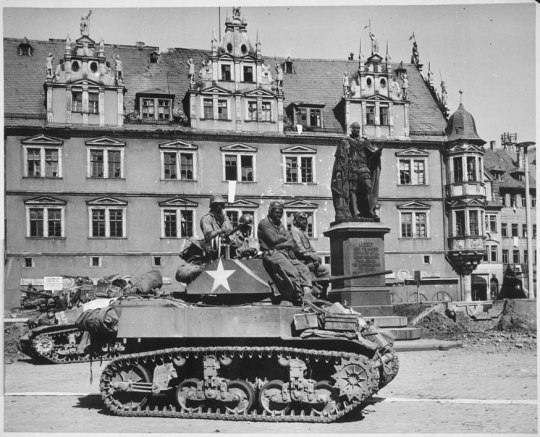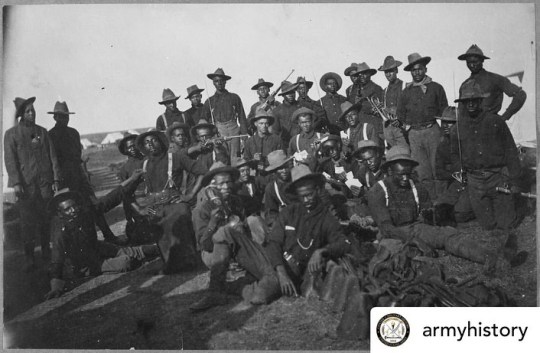#armyheritage
Photo

UNIT PROFILE– 761ST TANK BATTALION (COLORED) BLACK HISTORY MONTH Of the three armor battalions composed of Black soldiers in the segregated U.S. Army of World War II, the 761st "Black Panther" Tank Battalion is arguably the best known. Constituted on 15 March 1942 in the Army of the United States and activated on 1 April 1942 at Camp Claiborne, Louisiana, it was initially equipped with the M5 Stuart tank but transitioned to the M4 Sherman when the Army began fielding that system to the non-divisional armor units. After the battalion completed training in the United States - which included serving as the "aggressor" force against the student units of the tank destroyer school and participation in a phase of the Louisiana Maneuvers, the 761st was deemed "combat ready" and shipped overseas to the European Theater of Operations. Following a short stay in England, the battalion arrived in France on 10 October 1944, and was assigned to the Third Army commanded by the legendary proponent of armored warfare, Lieutenant General George S. Patton Jr. As a separate tank battalion, the 761st was attached to Infantry divisions - which had no organic armor units - for combat operations. As such, the "Black Panthers" entered combat for the first time on 7 November 1944. In 183 days of combat operations while attached to the all-white 26th, 71st, 79th, 87th, 95th and 103d Infantry Divisions, the 761st participated in the Allied drive through France, Patton’s relief of Bastogne during the Battle of the Bulge, and the breaching of the Siegfried Line. By the end of the war the Black Panthers had made it all the way to Austria (where they liberated the Gunskirchen concentration camp); the 761st was inactivated on 1 June 1946 in Germany. During WWII, the Black Panthers earned a Medal of Honor, a Presidential Unit Citation, 11 Silver Stars, 69 Bronze Stars, 296 Purple Hearts, and four campaign streamers (Northern France, Rhineland, Ardennes-Alsace, Central Europe). #Armyhistory #USArmy #TRADOC #WWII #WW2 #WW2History #Patton #Bastogne #BlackPanther #ShermanTank #BlackHistoryMonth #ArmyHeritage U.S. Army U.S. Army Training and Doctrine Command. #repostedfrom @armyhistory (at Columbia, Tennessee) https://www.instagram.com/p/CohszLPuF7Z/?igshid=NGJjMDIxMWI=
#armyhistory#usarmy#tradoc#wwii#ww2#ww2history#patton#bastogne#blackpanther#shermantank#blackhistorymonth#armyheritage#repostedfrom
19 notes
·
View notes
Photo

Reposted from @usarmy Rest in Peace, Soldier. Bradford Freeman, a World War II Veteran and the last living member of the famed "Band of Brothers" company, has died. He was 97. Pfc. Bradford Freeman of Easy Company, 506th Parachute Infantry Regiment, @101stabndivaa jumped into Normandy, #France on #DDay, June 6, 1944 with his fellow paratroopers and an 18-pound mortar baseplate strapped to his chest. Freeman was in every major engagement in Europe during World War II, and helped guide the realism of the HBO television series “Band of Brothers.” His experience helped the series emulate the reality of what Easy Company went through. His was part of the team that started with a “rendezvous with destiny” and helped build a legacy for all the past, present, and future Soldiers to have the honor to call themselves #ScreamingEagles. #ArmyLegacy #ArmyHeritage #NeverForget #hero #HonorThem (at United States) https://www.instagram.com/p/Cfr2UPkO9tT/?igshid=NGJjMDIxMWI=
0 notes
Link
0 notes
Photo

WISDOM WEDNESDAY – BLACK HISTORY MONTH "Men, you're the first Negro tankers to ever fight in the American Army. I would never have asked for you if you weren't good." – Lieutenant General George S. Patton Jr. addresses the men of the 761st “Black Panther” Tank Battalion in October 1944 #Armyhistory #USArmy #TRADOC #WWII #WW2 #WW2History #Patton #BlackPanther #BlackHistoryMonth #ArmyHeritage #MilitaryHistory Posted @withregram • @armyhistory (at Cornersville Highschool) https://www.instagram.com/p/CoZwgt7ubBI/?igshid=NGJjMDIxMWI=
#armyhistory#usarmy#tradoc#wwii#ww2#ww2history#patton#blackpanther#blackhistorymonth#armyheritage#militaryhistory
2 notes
·
View notes
Photo

UNIT PROFILE – 10TH U.S. CAVALRY REGIMENT (BUFFALO SOLDIERS) A trailblazing all-Black cavalry unit and the original “Buffalo Soldier” regiment, the 10th Cav. earned renown for its conduct in the Indian Wars, the War with Spain, and 1916’s Punitive Expedition. In the aftermath of the Civil War, Congress reorganized and downsized the U.S. Army, authorizing it to form six all-Black regiments, two of which were cavalry units: the 9th and 10th U.S. Cavalry Regiments (the four infantry regiments were quickly downsized to just two). Over three decades of fighting in the Indian Wars, the 10th and 9th Cav. participated in over 150 engagements, earning 17 Medals of Honor and the respect of their Native foes; the 10th Cav. was dubbed the “Buffalo Soldiers,” a nod to their courage and tenacity. The 10th Cav. furnished crack troops to the U.S. Army’s campaign in Cuba during the War with Spain in 1898, where they spearheaded the final assault up San Juan and Kettle Hills (the 10th Cav., the only unit to attack both peaks, took sizable casualties of around 20%). WWI hero John J. Pershing served as a young 1LT with the 10th Cav. and witnessed the Army’s capacity to foster racial harmony: “White regiments, black regiments … fought shoulder to shoulder, unmindful of race or color … mindful only of their common duty as Americans.” During WWII the 10th Cav. did not see combat and was dissolved in 1944. After years of dormancy, the 10th Cav. was revived in 1958 as a racially integrated unit which continued the lineage of the famed Buffalo Soldiers of the late 19th and early 20th centuries. #Armyhistory #USArmy #TRADOC #BuffaloSoldier #IndianWars #SpanishAmericanWar #Cavalry #BlackHistoryMonth #ArmyHeritage Posted @withregram • @armyhistory (at Middle Tennessee Area) https://www.instagram.com/p/Co11qbKOrmh/?igshid=NGJjMDIxMWI=
#armyhistory#usarmy#tradoc#buffalosoldier#indianwars#spanishamericanwar#cavalry#blackhistorymonth#armyheritage
0 notes
Photo

Private Henry Johnson, a North Carolinian soldier serving with the famous Harlem Hellfighters, became the first American soldier to earn the French Croix de Guerre, and received the Medal of Honor for actions taken on 15 May 1918 in the Argonne Forest. While on a night watch, Johnson and his squadmate Needham Roberts were set upon by a group of at least a dozen German raiders. Roberts was immediately wounded and captured, while Johnson engaged the enemy soldiers. After emptying his rifle, Johnson fought the Germans in desperate hand-to-hand combat. Using his bolo knife, rifle-butt, and bare hands, the 5’ 4” Johnson single-handedly dispatched at least four enemy soldiers, injuring several more and turning back the German squad. Despite having suffered over twenty wounds, Johnson pursued the Germans who were spiriting Roberts back to enemy territory and rescued his comrade. For what was dubbed by the American press “The Battle of Henry Johnson,” Johnson became the first American hero of World War One. Johnson’s actions proved that Black Americans could serve as bravely as any white soldier. Despite this, the racism of the time long delayed official recognition of his valor, and he was awarded the Medal of Honor posthumously in 2015. If you’re ready to be a part of #history & #armyhistory then contact me now 615-429-0932 #blacksoldiers #bearmystrong #bedifferent #theydiditwhycantyou #famoussoldiers #theydidit #whatsyourexcuse #Armyhistory #USArmy #TRADOC #WW1 #WW1History #HarlemHellfighters #MedalOfHonor #MOH #BlackHistoryMonth #ArmyHeritage Posted @withregram • @armyhistory (at Richland School) https://www.instagram.com/p/CopEB4eu58T/?igshid=NGJjMDIxMWI=
#history#armyhistory#blacksoldiers#bearmystrong#bedifferent#theydiditwhycantyou#famoussoldiers#theydidit#whatsyourexcuse#usarmy#tradoc#ww1#ww1history#harlemhellfighters#medalofhonor#moh#blackhistorymonth#armyheritage
0 notes
Photo

UNIT PROFILE – 54TH MASSACHUSETTS VOLUNTEER INFANTRY REGIMENT The Emancipation Proclamation’s promulgation in 1863 opened the Union Army’s ranks to Black soldiers for the first time, allowing Black Americans to fight for the Union’s preservation and the end of slavery. The 54th Massachusetts Volunteer Infantry Regiment was among the first all-Black units to be stood up. Led by COL Robert Gould Shaw (scion of a prominent abolitionist family) and promoted by prominent figures like Frederick Douglass, the 54th was flooded with recruits. Despite Confederate promises to punish captured Black soldiers and their white officers with summary execution for promoting “servile insurrection,” the 54th marched to war in high spirits, leaving Boston on 28 MAY. From 18 – 19 JUL the Union began operations to capture Fort Wagner (a critical part of the harbor defenses of Charleston, South Carolina) following an early unsuccessful attack from 10 – 11 JUL. Deploying a force of 5,000 infantry in a frontal assault, the Union placed the 54th in the vanguard of the attack force, sending them charging across an open field towards Ft. Wagner under withering rifle and artillery fire rained on them by the 1,800 Confederate defenders. COL Shaw led the 54th up the fortifications, rallying his men with a cry of “Forward Fifty-Fourth!” from atop the ramparts before being killed. Despite their commander’s death the 54th pushed on, engaging the rebels in bitter hand-to-hand fighting. Despite 54th’s best efforts, the Union was unable to break through the fort’s defenses; the 54th paid an exorbitant price for its extraordinary valor, suffering a staggering 42% casualty rate (280 of the 600 of its men who fought in the Second Battle of Ft. Wagner). The stories of the 54th’s heroism quickly spread across the Union, motivating Black Americans to enlist in the U.S. Army. Between 1863 and 1865 nearly 200,000 Black soldiers served the cause of liberty, contributing roughly 10% of the U.S. Army’s Civil War manpower. #Armyhistory #USArmy #TRADOC #CivilWar #CivilWarHistory #ArmyHeritage #MilitaryHistory #BlackHistoryMonth #54thmassachusetts Posted @withregram • @armyhistory (at Army Recruiting Columbia, TN) https://www.instagram.com/p/CocK6HVutK2/?igshid=NGJjMDIxMWI=
#armyhistory#usarmy#tradoc#civilwar#civilwarhistory#armyheritage#militaryhistory#blackhistorymonth#54thmassachusetts
0 notes
Photo

Posted @withregram • @armyhistory A self-taught artillerist, Henry Knox seems an unlikely father to the U.S. Army’s Artillery Corps; despite this, Knox’s mastery over the “King of Battle” proved instrumental to American victory in the Revolutionary War. By the time Knox joined the Revolution in April of 1775, he had tutored himself in military engineering and field artillery. At the Battle of Bunker Hill, Knox directed artillery fire against the Redcoats, and when the Continentals withdrew from Boston to besiege the city, Knox designed Patriot defensive fortifications. Within a few months of General Washington’s arrival outside Boston in the summer of 1775, he entrusted Knox with a vital task: procuring the guns of Ft. Ticonderoga. The Vermonter Ethan Allen had captured the British stronghold in May of 1775, along with its artillery pieces; the capture of these heavy guns was a boon to the Revolution, which needed artillery to force the British from Boston, but their location deep in the woods of Upstate New York made them nearly inaccessible. When Knox arrived at the fort on 5 December, 1775, he faced the harrowing prospect of moving 120,000 pounds of artillery 300 miles during a New England winter. Undaunted, Knox organized a convoy he dubbed his “noble train”, transporting his 60 ton payload across inhospitable terrain over 40 days of brutal drudgery. Knox arrived back in Gen. Washington’s camp in late January, having lost not one of his 59 guns; in March, his artillery occupied the high ground at Dorchester Heights, south of Boston. With command over the city and its harbor, the Continentals forced the British to withdraw, winning one of the Revolution’s first victories. Knox was quickly made commander of the Continental Army’s artillery, and became one of Gen. Washington’s most valued advisors and handpicked successor as leader of the Army. When Gen. Washington was elected President in 1789, he chose Gen. Knox to be the first U.S. Secretary of War. #Armyhistory #USArmy #TRADOC #FieldArtillery #ArmyHeritage #ArmyBday https://www.instagram.com/p/Ce4ZbavudY_/?igshid=NGJjMDIxMWI=
0 notes